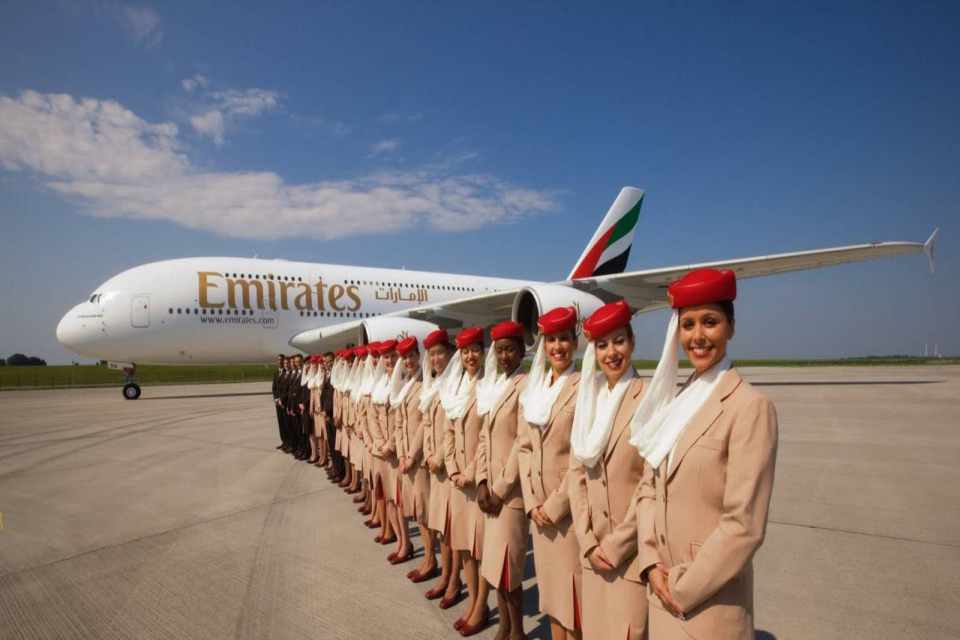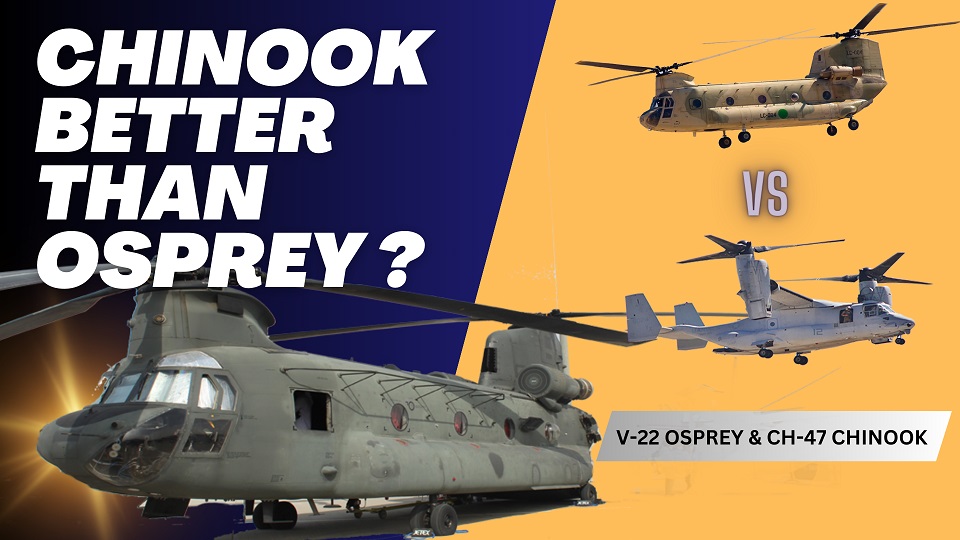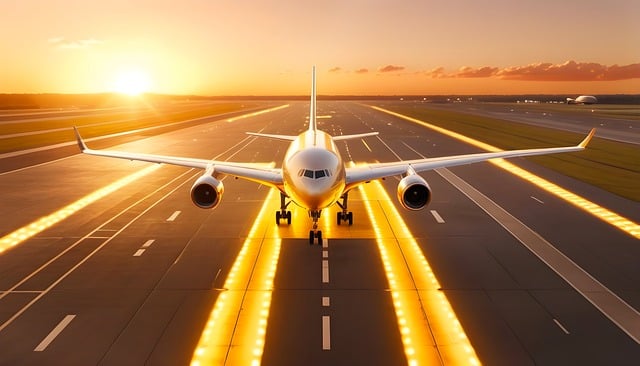Aviation
Interesting facts about Emirates Airlines Airbus A380

- Emirates was the first airline to order the Airbus A380 back in 2000
- Emirates is the world’ largest A380 operator, flying this iconic double-decked aircraft to 48 cities on six continents on scheduled services
- Including one-off flights, special commemorative services, test flights, and other operational deployments, 70 airports to date have welcomed the Emirates A380, including Munich, Frankfurt, Düsseldorf, Hamburg (one-off 100th airport anniversary), Berlin (ILA Berlin Air Show), Dresden (EWF/Airbus) and Cologne (German Aerospace Day 2015) in Germany
- Emirates has ordered a total of 142 A380s at a total value of 61b US$ in list prices
- One in every three A380s in the sky today is an Emirates aircraft. Its order book represents over 40 percent of the total orders received by Airbus for this aircraft
- Of Emirates’ 100 A380s, 13 are in dual-class configuration (Business/Economy Class)
- Each A380 flight has 24 cabin crew and two cabin service assistants working aboard
- Over 23,000 cabin crew and 1,500 flight deck crew are specially trained to operate the A380 fleet
- At the iconic A380 Onboard Lounge mixologists can whip up to 14 different types of cocktails. Emirates has over 6,000 crew trained as mixologists
- The shortest Emirates A380 flight is Dubai to Kuwait (851 kilometres). The longest Emirates A380 flight is Dubai to Auckland (14,193 kilometres)
- In 2016-17 Emirates received 19 new A380s, its highest number during a financial year
- After every seven to eight years in service, Emirates fully strips its aircraft of their exterior color and gives them a brand-new coat. An A380 requires a team of 34 people for a full strip and repaint project, which required almost 6,000 man hours or 15 days. The paint covers an area of 3,076 square metres
- The newly re-designed Onboard Lounge can accommodate up to 26 passengers at a time, including eight seated
- Production costs of one First Class private suite are valued at US$ 500,000
- Emirates’ sponsored clubs Arsenal FC, Real Madrid, Paris Saint Germain and AC Milan all had an A380 in dedicated special livery during recent years
- At ILA Berlin Air Show 2010, Emirates placed an order with Airbus for additional 32 A380s at a list price of US$ 11.5 billion. The agreement was signed by H.H. Sheikh Ahmed bin Saeed Al-Maktoum, Chairman and Chief Executive, Emirates Airline and Group, in the presence of German Chancellor Angela Merkel and other dignitaries
- Hollywood actress, director and producer Jennifer Aniston starred in two global Emirates A380 digital and TV advertising campaigns (2015 and 2016)
- In January 2013, Emirates opened Concourse A, the dedicated home of its A380 fleet and the world’s first purpose-built facility for the aircraft at Dubai International Airport, comprising 20 A380-capable contact gates, as well as Emirates’ flagship First and Business Class lounges, the largest in the world
- Dubai Miracle Garden displays the world’s largest floral installation through a life-size version of the Emirates A380, covered in more than 500,000 fresh flowers and living plants. In full bloom, the aircraft structure has an unprecedented total stem count of five million flowers and weighs over 100 tonnes
- 530 kilometres of cables are laid in one A380, the beeline distance between Hamburg and Stuttgart
- The full list of the 48 Emirates A380 destinations: Amsterdam, Auckland, Bangkok, Barcelona, Beijing, Birmingham, Brisbane, Casablanca, Christchurch, Copenhagen, Dubai, Dusseldorf, Frankfurt, Guangzhou, Hong Kong, Jeddah, Johannesburg, Kuala Lumpur, Kuwait, London (LHR and LGW), Los Angeles, Madrid, Milan, Manchester, Mauritius, Melbourne, Moscow, Mumbai, Munich, New York (JFK), Nice, Paris (CDG), Perth, Prague, Rome, San Francisco, Sao Paulo, Seoul, Shanghai, Singapore, Sydney, Taipei, Tokyo-Narita, Toronto, Washington D.C., Vienna and Zurich
- Capacity of the Emirates A380 fleet
- Long cruising range, 3 classes, 489 seats (F14/J76/Y399)
- Medium cruising range, 3 classes, 517 seats (F14/J76/Y427)
- Medium cruising range, 3 classes, 519 seats (F14/J76/Y429)
- Medium cruising range, 2 classes, 615 seats (J58/Y557)

Aircraft comparison
Osprey is faster than Chinook helicopter ?

In this article, we’ll delve into two distinct military aircraft that have played essential roles in United Air Force defense. Both aircraft have unique characteristics in terms of usage and flying capabilities. One is capable of vertical takeoff and flies like an aircraft, while the other is a helicopter with two tandem rotors. Let’s explore each of these aircraft in detail.
The speed of helicopters can vary depending on several factors such as their design, engine power, payload, and mission requirements. Generally speaking, the Osprey (specifically referring to the V-22 Osprey) is faster than the Chinook helicopter.
The V-22 Osprey is a tiltrotor aircraft, meaning it can take off and land vertically like a helicopter but also tilt its rotors forward to fly like an airplane. This design allows the Osprey to achieve higher speeds compared to conventional helicopters. The cruising speed of the V-22 Osprey is around 241 knots (277 mph or 446 km/h).
On the other hand, the Chinook helicopter, such as the Boeing CH-47 Chinook, has a cruising speed typically around 170 knots (196 mph or 315 km/h). While the Chinook is a highly capable and versatile helicopter known for its heavy-lift capabilities and reliability, it generally operates at lower speeds compared to the Osprey.
The comparison between an Osprey and a Chinook helicopter involves contrasting two distinct aircraft with different designs, capabilities, and purposes:
MV-22 Osprey details:
The Osprey has garnered significant controversy since its inaugural flight, primarily stemming from issues associated with its tiltrotor design. These challenges have led to several incidents and crashes, resulting in the tragic loss of pilots and crew members and prompting multiple groundings of the aircraft.
However, efforts are underway to address these technical issues swiftly, with plans to rectify the problems and resume flights promptly. Despite these setbacks, the Osprey remains crucial in operational contexts, offering enhanced capabilities for transporting both cargo and crew members, underscoring its pivotal role in various missions.
Except for the United States and Japan, no other country has been granted authorization to utilize the Osprey aircraft. Its unique design and specialized nature, being built in the United States, likely necessitate governmental permission for export to other nations.
The Osprey stands out for its groundbreaking design and innovation, featuring the ability to transition from vertical to horizontal rotor positions while also generating thrust like a conventional aircraft.
- MV-22 Osprey:
- The MV-22 Osprey is a tiltrotor aircraft, meaning it can take off and land like a helicopter but fly like a fixed-wing aircraft once airborne.
- It’s primarily used for vertical takeoff and landing (VTOL), troop transport, cargo transport, and aerial refueling.
- The Osprey has a unique ability to combine the vertical lift capability of a helicopter with the speed and range of a turboprop aircraft.
- It can carry up to 24 troops or 20,000 pounds of internal cargo and has a top speed of around 315 miles per hour (507 km/h).
- The Osprey is utilized by the U.S. Marine Corps, U.S. Air Force Special Operations Command, and other military forces around the world.
Boeing CH-47 Chinook:
The Chinook helicopter stands as a testament to unparalleled engineering and innovation, making it one of the most distinctive aircraft ever constructed. Since its inception, no other nation has attempted to replicate its singular design, owing to the extraordinary precision and aerospace technology required for its construction. This helicopter, revered as an engineering marvel, has become a staple in major battlegrounds, renowned for its exceptional capacity to transport troops and cargo to any destination. Remarkably versatile, it operates seamlessly on both land and water surfaces, boasting an integrated floating system that enhances its capabilities even further.
Selected countries have been granted permission to utilize the Chinook helicopter, showcasing its global appeal and strategic importance. Furthermore, ongoing development efforts are underway to enhance the speed and carrying capacity of the next version of this iconic aircraft. Renowned for its exceptional safety record, the Chinook stands as one of the safest helicopters in operation today, with a remarkably low incidence of crashes. Its versatility is unmatched, making it an invaluable asset for operations in diverse terrains and environments.
- Boeing CH-47 Chinook:
- The Chinook is a tandem rotor helicopter, known for its distinctive twin-rotor design.
- It’s a heavy-lift helicopter primarily used for troop transportation, artillery emplacement, battlefield resupply, and various other missions.
- The Chinook has a rear loading ramp for cargo and troops, making it well-suited for quick loading and unloading.
- It can carry up to 55 troops or 24,000 pounds of cargo internally and has a top speed of around 170 miles per hour (274 km/h).
- The Chinook is widely used by the U.S. Army and various other military forces worldwide, including the UK, Canada, and others.
Comparison:
- Design: The Osprey is a tiltrotor aircraft, while the Chinook is a tandem-rotor helicopter.
- Speed and Range: The Osprey has a higher top speed and longer range compared to the Chinook due to its fixed-wing aircraft capabilities.
- Payload Capacity: The Chinook generally has a higher payload capacity for both troops and cargo compared to the Osprey.
- Versatility: While both aircraft are versatile in their own right, Osprey’s ability to take off and land vertically as well as fly at high speeds over long distances gives it a unique advantage in certain scenarios. However, the Chinook’s ability to carry larger payloads makes it better suited for heavy lift operations.
- Cost and Maintenance: Maintenance and operating costs may vary between the two aircraft, with tiltrotor technology typically being more complex than traditional helicopter designs.
Most Popular .
These are the Top 10 best US airlines of 2024

In an era where air travel plays an integral role in connecting people and places, the quality of airline service can significantly impact travelers’ experiences.
As we navigate the ever-changing landscape of aviation, insights into the performance and reliability of different carriers become invaluable. Enter WalletHub’s comprehensive analysis, offering a glimpse into the 10 best US airlines of 2024. Join us as we embark on a journey through the clouds, exploring the top performers.
Best airlines of 2024
- Alaska Airlines (68.07 out of 100): Anchoring the list is Alaska Airlines, celebrated for its consistency and customer satisfaction. With a score of 68.07, Alaska Airlines sets the standard for excellence in the skies.
- SkyWest Airlines (65.96): Following closely behind is SkyWest Airlines, recognized for its operational prowess and reliability. With a score of 65.96, SkyWest secures its position among the elite.
- Spirit Airlines (65.69): Surging into third place is Spirit Airlines, renowned for its affordability and expansive route network. Despite its low-cost model, Spirit Airlines earns acclaim with a score of 65.69.
- Delta Air Lines (61.56): A stalwart of the industry, Delta Air Lines maintains its reputation for superior service and efficiency. With a score of 61.56, Delta continues to soar above the competition.
- United Airlines (51.96): United Airlines occupies the middle ground, offering a balance of convenience and comfort to travelers. With a score of 51.96, United remains a dependable choice for domestic and international flights.
- JetBlue Airways (51.6): JetBlue Airways, known for its focus on customer experience and amenities, secures its place in the top 10 with a score of 51.6.
- Hawaiian Airlines (48.3): Transporting passengers, Hawaiian Airlines earns accolades for its hospitality and island-inspired service. With a score of 48.3, Hawaiian Airlines embodies the spirit of aloha.
- American Airlines (46.52): Despite facing challenges, American Airlines maintains its presence among the top performers with a score of 46.52, showcasing resilience in the competitive aviation landscape.
- Frontier Airlines (43.57): Frontier Airlines offers budget-conscious travelers a gateway to the skies with its affordable fares and diverse destinations. With a score of 43.57, Frontier Airlines secures its place in the top 10.
- Southwest Airlines (36.03): Rounding out the list is Southwest Airlines, renowned for its no-frills approach and extensive route network. With a score of 36.03, Southwest Airlines remains a popular choice for travelers seeking simplicity and value.
Aviation
South Korea Introduces Cutting-Edge MRO Center for F-35 and IAI

South Korea is set to make waves in the aerospace industry with the establishment of a cutting-edge Maintenance, Repair, and Overhaul (MRO) hub for F-35 fighter jets and IAI (Israel Aerospace Industries) aircraft.
Central to this initiative is the specialization in converting Boeing 777-ERSF, colloquially known as the “Big Twin,” from passenger to freighter configurations. Under the terms of the agreement, IAI will spearhead the conversion of six B777-300ER and B777-200LR aircraft annually, commencing in 2024. This strategic move is in response to the anticipated surge in demand for wide-body freighter aircraft capable of long-haul flights.
Furthermore, South Korea’s forward-looking vision extends beyond aircraft conversion, with plans to establish a Lockheed Martin F-35 maintenance, repair, and overhaul depot at Cheongju Air Base by 2027. This strategic move not only enhances the operational readiness of South Korea’s air force but also positions the nation as a regional hub for F-35 maintenance expertise.
In preparation for this expansion, thirty Republic of Korea Air Force (ROKAF) engineers and technicians are slated to undergo intensive maintenance training in the United States in 2025, a testament to South Korea’s commitment to fostering local expertise and talent.
IAI’s visionary approach to certification and collaboration underscores the potential for transformative change. With plans for the 777-300ERSF certification process set to unfold in Israel, followed by the rigorous scrutiny of regulatory agencies such as the US Federal Aviation Administration (FAA), the stage is set for the ‘Big Twin’ to soar to new heights of success.
In partnership with esteemed entities like STK and Incheon International Airport Corporation, this collaboration promises to unleash a wave of benefits, amplifying the resilience and competitiveness of the Korean aviation sector while catalyzing job creation and economic prosperity.





























